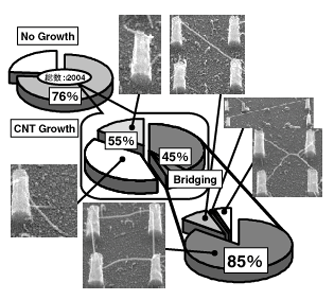Device Physics Laboratory
Ā@In the application of semiconductor nanostructures to electronic devices, interconnections between individual nanostructures are very important for transmitting and processing signals. However, with traditional wiring technology, it is quite difficult to fabricate the connections between ultra-fine and dense nanostructures. To overcome this problem, we have proposed wafer-scale nanointerconnection based on carbon nanotube (CNT) self-assembly [1,2]. CNTs are promising for wiring and connecting nano-scale devices because of their peculiar mechanical and electrical properties. We have succeeded in fabricating a CNT network on an array of nanometer-scale Si pillars.
Ā@Figure 1 shows statistical distribution of CNT growth behavior analyzed from samples with Si pillar structure after CNT growth (see frontispiece). A CNT was grown by thermal chemical vapor deposition (CVD) with an iron catalyst. The CNT was observed to grow on 3/4 of the Si pillars and about half of the grown CNT bridged the pillars in an orderly manner. Such self-organized ordered bridging may be fairly anomalous since the CNT growth is ordinarily postulated to be random in the thermal CVD process. We have proposed a bridging growth mechanism where CNTs vibrate within a limited direction around a pillar and "search" for a neighboring pillar to stick to. The structure of the CNT was characterized by micro-Raman spectroscopy in order to confirm this mechanism. Figure 2 compares the Raman spectra from a pillar-fabricated region and a flat region containing no pillars. The Raman bands at 1316 cm-1 originate from the lowering of the translational symmetry due to defects. The spectra show that the bridging CNTs are more defective than those on the flat region, although the bridging CNTs are observed to grow in linear manner and are supposed to be less defective. This suggests that defects are formed by the vibration of CNTs during bridging growth, which agrees with our growth mechanism.
[1] Y. Homma et al., Jpn. J. Appl. Phys. 41 (2002) L89.
[2] Y. Homma et al., Physica B in press.
 |
 |
||||
|
|